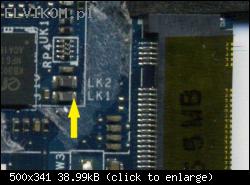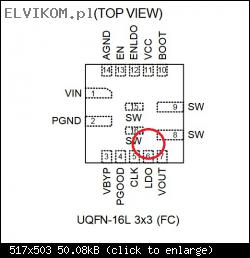Zasady działu: Kliknij, aby przejrzeć zasady tego działu
- Tytuł wątku powinien zawierać markę i pełny model sprzętu oraz skrótowy opis usterki.
- Treść wątku powinna zawierać dokładny opis usterki, co zostało sprawdzone/wymienione/zmierzone, wyniki tych działań, oznaczenie kodowe PCB (w przypadku napraw hardware) oraz sformułowane pytanie. W przypadku problemów z odczytaniem oznaczenia kodowego PCB, należy przeczytać TEN WĄTEK. Jeśli nadal nie można znaleźć oznaczenia, należy zamieścić wyraźne zdjęcia obu stron płyty - należy przy tym usunąć wszelkie folie i moduły, mogące ewentualnie zasłaniać oznaczenia płyty.
- Przed napisaniem nowego tematu, każdy użytkownik zobowiązany jest zapoznać się z wątkami w dziale SZKOLENIA i na ich podstawie dokonać próby wstępnej diagnostyki uszkodzenia.
- Nie jest dozwolone umieszczanie załączników w postaci kompletnych dokumentacji, a także jakichkolwiek wsadów BIOS / firmware (do tego służy dział PLIKI BIOS DO WERYFIKACJI). Dozwolone jest wyłącznie umieszczenie fragmentu dokumentacji, który ułatwi autorowi diagnostykę/naprawę sprzętu z wątku. W jednym poście można zamieścić nie więcej, niż jedną stronę instrukcji/schematu. Plik nie może posiadać widocznych znaków wodnych, napisów "confidential", adresów email etc.
- Nie jest dozwolone zamieszczanie linków do plików, znajdujących się na innych stronach internetowych.
- Nie jest dozwolone zakładanie tematu, który opisuje usterkę więcej niż jednego sprzętu. W takich przypadkach należy utworzyć osobne wątki dla każdego sprzętu.
- Nie jest dozwolone pisanie tematu lub postu, mającego charakter zapytania o schemat, boardview, zdjęcia płyty, wsad BIOS lub instrukcję serwisową. Do takich zapytań służy dział ZAPYTANIA O DOKUMENTACJE/BIOS.
To jest wątek ARCHIWALNY. Możesz odpowiedzieć w nim tylko wtedy, gdy Twój post zawiera rozwiązanie problemu (Regulamin forum p. 12.1).
Re: Re: HP Envy 13-D (LA-C482P) - Liquid Damage
przez Google Adsense [BOT] • 15 stycznia 2020, 21:48
(note that jumper PJ302 is still open)
With jumper PJ301 open and plugged into lab PSU the board consumes 0.01a (10mA). I have no light on DC jack also.
With jumper PJ301 closed and plugged into lab PSU the board consumes 0.07a (70mA). DC jack light is on.
Would this mean somthing is partial short on the +3VL line?
With jumper PJ301 open and plugged into lab PSU the board consumes 0.01a (10mA). I have no light on DC jack also.
With jumper PJ301 closed and plugged into lab PSU the board consumes 0.07a (70mA). DC jack light is on.
Would this mean somthing is partial short on the +3VL line?
KenM0560 napisał(a):Wouldnt the 10mA be consumed by PUB1 (ISL95520HRZ)?Possible, but it is not necessary.
Remove the chip PUB1 from the board and supply the board with a laboratory power supply directly on resistor PRB1. Measure the power consumption of the board in this case.
Note that the transistor PQB1 should be also removed from the board during this test.
(Still with jumper PJ301 open, PU302 removed and PL301 removed)
After removing PUB1 and PQB1 and injecting 19v with the lab power supply at PRB1, 0a current is consumed.
Excuse my lack of knowledge, but in working conditions with adapter plugged in and before power button is pressed, shouldnt laptop consume around 0.01a anyway?
After removing PUB1 and PQB1 and injecting 19v with the lab power supply at PRB1, 0a current is consumed.
Excuse my lack of knowledge, but in working conditions with adapter plugged in and before power button is pressed, shouldnt laptop consume around 0.01a anyway?
KenM0560 napisał(a):Excuse my lack of knowledge, but in working conditions with adapter plugged in and before power button is pressed, shouldnt laptop consume around 0.01a anyway?Yes, but with 3,3V and 5V present.
In your case that current is consumed when the 3V and 5V converters are disabled. I think it is too much in this case.
Try to replace the charger chip and remeasure the current consumption of the board (leave the transistor PQB1 and other components off the board).
@matic I replaced PUB1 with another and still current consumption is 0.01a. (With PJ301 open and PU302 removed from board still)
I have 19V at PRB1 and 14V at PRB2, with only adapter plugged in.
Shouldnt there only be voltage at PRB2 when battery is plugged in to charge? Would this be reason for extra power consumption without the 3v/5v IC connected?
I have 19V at PRB1 and 14V at PRB2, with only adapter plugged in.
Shouldnt there only be voltage at PRB2 when battery is plugged in to charge? Would this be reason for extra power consumption without the 3v/5v IC connected?
KenM0560 napisał(a):I have 19V at PRB1 and 14V at PRB2, with only adapter plugged in.Before you get different voltage on coil PLB1 (PRB1):
KenM0560 napisał(a):Voltage / ResistanceWhich one is correct?
PLB1= 11.1v / .290M
KenM0560 napisał(a):Shouldnt there only be voltage at PRB2 when battery is plugged in to charge?The main power rail on that board is designed little different as usual. I don't know if this is a reason for a higher power consumption.
Re: HP Envy 13-D (LA-C482P) - Liquid Damage
przez Google Adsense [BOT] • 29 stycznia 2020, 21:52
To jest wątek ARCHIWALNY. Możesz odpowiedzieć w nim tylko wtedy, gdy Twój post zawiera rozwiązanie problemu (Regulamin forum p. 12.1).
Kto przegląda forum
Użytkownicy przeglądający ten dział: Brak zidentyfikowanych użytkowników i 4 gości
_______________________________Wszelkie prawa zastrzeżone. Zabrania się kopiowania jakichkolwiek treści i elementów witryny bez zezwolenia.
Wszelkie opublikowane na tej stronie znaki handlowe, nazwy marek, produktów czy usług należą do ich prawnych właścicieli i zostały użyte wyłącznie w celach informacyjnych.




